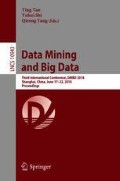Abstract
Nowadays, recommender systems are widely used to solve the problem of information overload in modern society. And most of the previous studies focus overwhelmingly on high accuracy in the recommender systems. But in a real system, the high accuracy does not always satisfy overall user experience. The explainability has a great impact on the user experience. We mainly focus on the explainability of recommender systems in this paper. To the best of our knowledge, it is the first time that the neighborhood information in the latent space is integrated into the Explainable Matrix Factorization. We change the method of calculation of the explainability matrix and consider the neighbors’ weight to further improve performance. We use the benchmark data set (MovieLens) to demonstrate the effectiveness of the proposed Neighborhood-based Explainable Matrix Factorization. And the result shows a great improvement for accuracy and explainability.
Access this chapter
Tax calculation will be finalised at checkout
Purchases are for personal use only
References
Abdollahi, B., Nasraoui, O.: Explainable matrix factorization for collaborative filtering. In: International Conference Companion on World Wide Web, pp. 5–6 (2016)
Abdollahi, B., Nasraoui, O.: Using explainability for constrained matrix factorization. In: The Eleventh ACM Conference, pp. 79–83 (2017)
Amatriain, X.: Past, present, and future of recommender systems: an industry perspective. In: International Conference on Intelligent User Interfaces, p. 1 (2016)
Bell, R.M., Koren, Y.: Scalable collaborative filtering with jointly derived neighborhood interpolation weights. In: IEEE International Conference on Data Mining, pp. 43–52 (2007)
Davis, J., Goadrich, M.: The relationship between precision-recall and ROC curves. In: International Conference on Machine Learning, pp. 233–240 (2006)
Gedikli, F., Jannach, D., Ge, M.: How should i explain? A comparison of different explanation types for recommender systems. Int. J. Hum. Comput. Stud. 72(4), 367–382 (2014)
Harper, F.M., Konstan, J.A.: The MovieLens datasets: history and context. ACM Trans. Interact. Intell. Syst. (TiiS) 5(4) (2016). Article No. 19
Hu, Y., Koren, Y., Volinsky, C.: Collaborative filtering for implicit feedback datasets. In: Eighth IEEE International Conference on Data Mining, pp. 263–272 (2009)
Koren, Y.: Factorization meets the neighborhood: a multifaceted collaborative filtering model. In: ACM SIGKDD International Conference on Knowledge Discovery and Data Mining, pp. 426–434 (2008)
Koren, Y., Bell, R., Volinsky, C.: Matrix factorization techniques for recommender systems. Computer 42(8), 30–37 (2009)
Manning, C.D., Raghavan, P., Schtze, H.: Chapter 8: Evaluation in Information Retrieval. Cambridge University Press, New York (2009)
Paterek, A.: Improving regularized singular value decomposition for collaborative filtering. In: Proceedings of KDD Cup Workshop (2007)
Powers, D.M.W.: Evaluation: From precision, recall and f-measure to ROC, informedness, markedness correlation. J. Mach. Learn. Technol. 2(1), 37C63 (2011)
Vig, J., Sen, S., Riedl, J.: Tagsplanations: explaining recommendations using tags. In: International Conference on Intelligent User Interfaces, pp. 47–56 (2009)
Zhang, Y., Lai, G., Zhang, M., Zhang, Y., Liu, Y., Ma, S.: Explicit factor models for explainable recommendation based on phrase-level sentiment analysis. ACM (2014)
Acknowledgement
This work was supported by the National Natural Science Foundation of China (No. 61602048) and the Fundamental Research Funds for the Central Universities (No. NST20170206).
Author information
Authors and Affiliations
Corresponding author
Editor information
Editors and Affiliations
Rights and permissions
Copyright information
© 2018 Springer International Publishing AG, part of Springer Nature
About this paper
Cite this paper
Wang, S., Tian, H., Zhu, X., Wu, Z. (2018). Explainable Matrix Factorization with Constraints on Neighborhood in the Latent Space. In: Tan, Y., Shi, Y., Tang, Q. (eds) Data Mining and Big Data. DMBD 2018. Lecture Notes in Computer Science(), vol 10943. Springer, Cham. https://doi.org/10.1007/978-3-319-93803-5_10
Download citation
DOI: https://doi.org/10.1007/978-3-319-93803-5_10
Published:
Publisher Name: Springer, Cham
Print ISBN: 978-3-319-93802-8
Online ISBN: 978-3-319-93803-5
eBook Packages: Computer ScienceComputer Science (R0)

